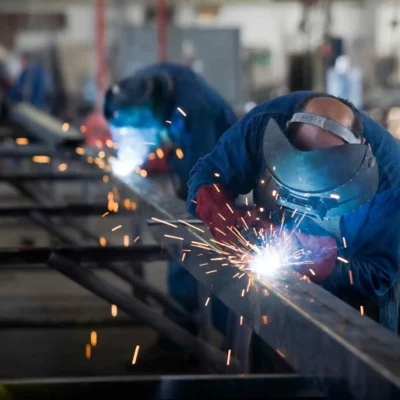At the Motek & Vision 2022 trade fair in Stuttgart, we saw a lot of AMRs. They caught our interest, and we wanted to learn more about them.
Many types of businesses, like farms, hospitals, warehouses, and delivery companies, want to work smarter. They want to do things better and more safely. That’s why they’re interested in autonomous mobile robots (AMRs).
So, let’s dive right in.
What are Autonomous Mobile Robots (AMRs)?
An Autonomous Mobile Robot, or AMR, is a computer-controlled machine. It has sensors and technology to see where it is and move around.
In simple terms, AMRs are like computers on wheels, and they use AI and physical parts like wheels or legs to do their jobs.
These robots are made to make manufacturing and moving things around more efficient. We’ll talk more about where you can find them and what they do in a bit.
How do AMRs work?
AMRs have cameras and sensors. When they bump into things they didn’t expect, like a box in their way or a group of people, they use techniques to avoid crashing. This means they can slow down, stop, or find a new path around the object. Then, they keep doing their job.

Han’s Robots has a smart robot called HR Mobile Robot. It’s like a helpful assistant in big buildings. It can carry things safely and go around without hitting things.
This robot is super quick to recharge, so it doesn’t stop working for a long time. It’s good for factories and other big places where they need to move stuff around. It keeps things safe and doesn’t bump into things. It’s really handy for making work faster and easier.
Difference Between an AGV & an AMR?
AMRs and AGVs are alike in what they do, but they have some key distinctions.
An AMR is smart and can move around on its own, figuring out where to go. But an AGV follows set paths or tracks. AGVs often need someone to watch over them.
Industries & Applications:
AMRs have various uses across different industries:
1. Hospitals & Healthcare:
In hospitals, they help with tasks like disinfecting, delivering medicine, and even telepresence. This frees up staff to spend more time with patients.
2. Hospitality:
Retail, banks, and hospitality use AMRs to improve customer experiences. They assist with customer service, handle inventory, provide room service, carry luggage, and guide customers.
3. Pharmaceuticals:
In pharmaceuticals, AMRs safely move hazardous materials around. They can also transport products from warehouses to production lines.
4. Accessing Dangerous Areas:
In places like fires, nuclear facilities, and military zones where it’s risky for people, AMRs are used. They can handle tasks in these dangerous and toxic environments.
5. Manufacturing, Warehousing, and Logistics:
AMRs are a big help in these industries. They can do heavy or light tasks, deliver items to humans, and ensure safety and security.
6. Entertainment (Casinos):
Even in casinos, AMRs come into play. They serve drinks and snacks, making the experience enjoyable for customers.
Benefits:
Let’s talk about the benefits of AMRs:
1. Enhanced Safety for Staff:
AMRs are a big help in tasks that might be dangerous or impossible for people. For example, in healthcare, they clean and disinfect to keep things safe. They can also move harmful stuff in pharmaceuticals, lift heavy things in industries, and work in tough conditions.
2. Increased Flexibility:
Unlike AGVs, AMRs can figure out what’s around them and adjust to it while doing different jobs. They don’t need someone watching them all the time. Thanks to their mapping tech, AMRs can understand and change with their environment. This makes them super useful in lots of industries.
3. Increased Efficiency and Productivity:
To get the most out of your staff, you can use AMRs. Your employees can focus on important things, and AMRs can help with moving stuff and finding things. Being efficient and productive is crucial for any successful company. If needed, you can easily change how AMRs work, like where they go and what they do, which keeps things running smoothly.
Conclusion:
If what we’ve talked about makes sense for your business, Autonomous Mobile Robots might be a good fit. But, it really depends on what your business needs.
To figure out what’s best, it’s smart to talk to an experienced systems integrator. They can give you the right advice and analysis for your business.
Discover how AMRs can revolutionize your business and join our community to learn more and connect with experts at Qviro Community!







I’m really impressed with your writing skills as well as with the layout on your weblog. Is this a paid theme or did you customize it yourself? Either way keep up the excellent quality writing, it’s rare to see a nice blog like this one nowadays.
Thanks for sharing such a unique and useful article, it’s great.